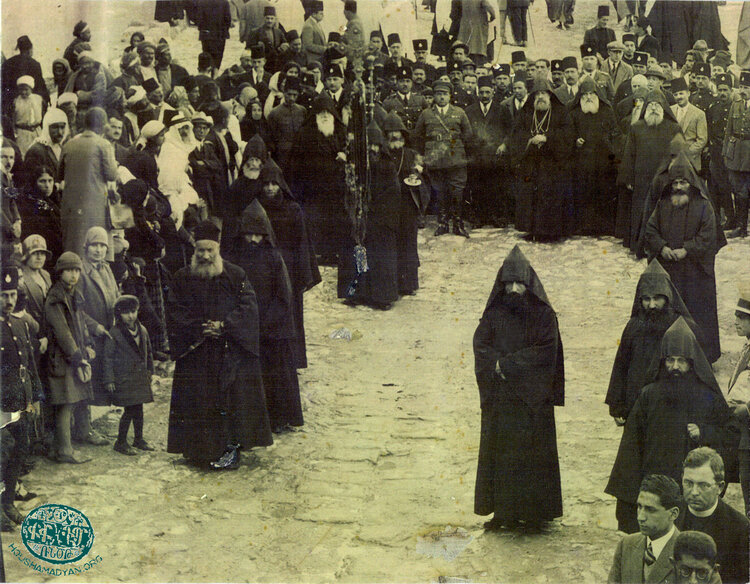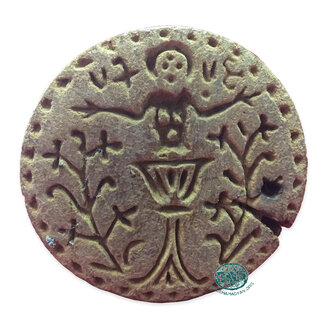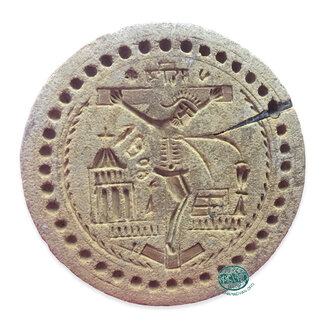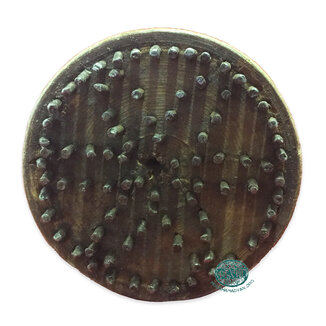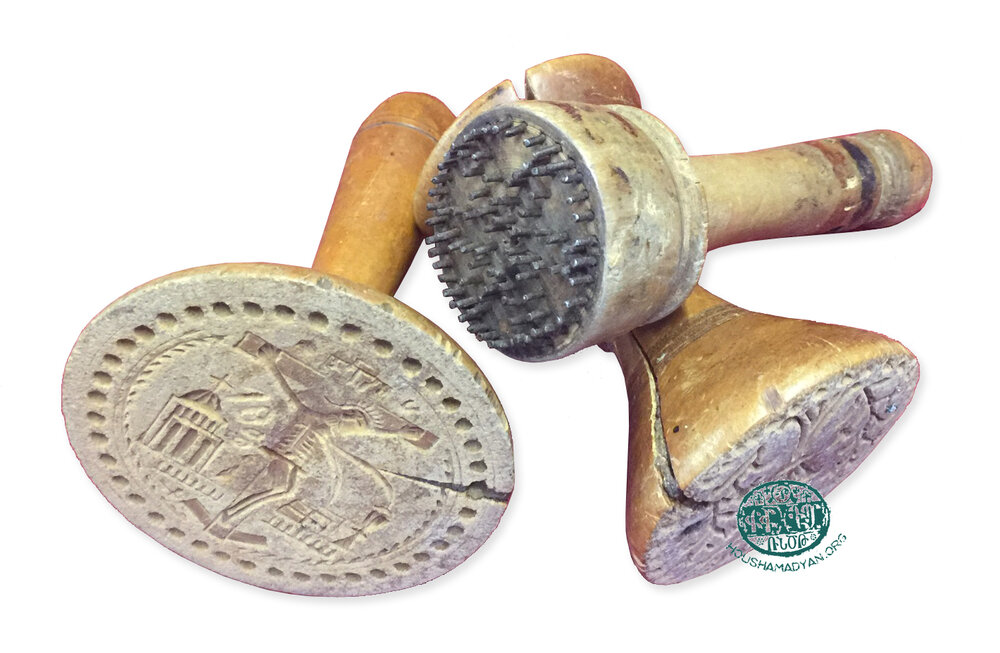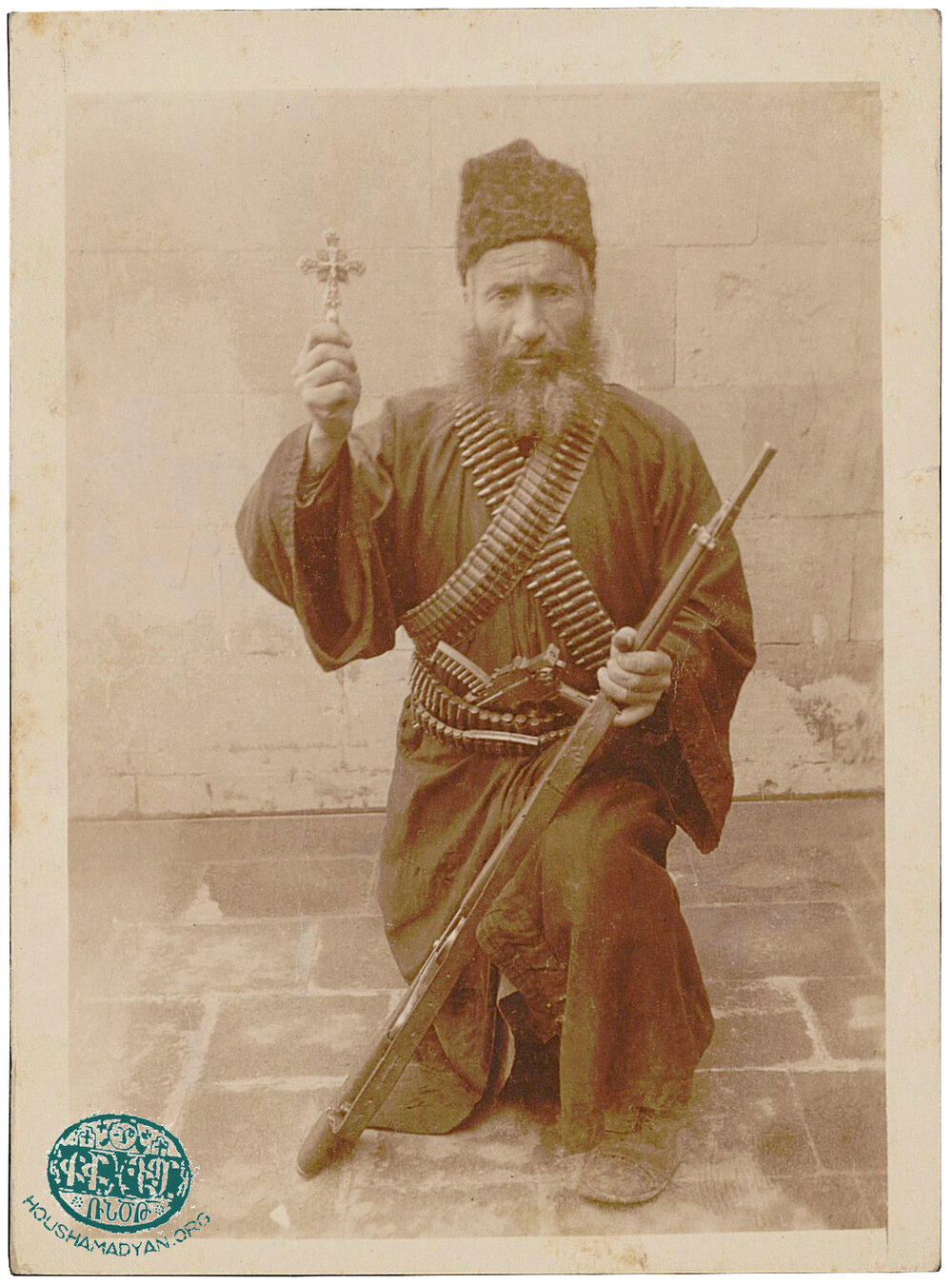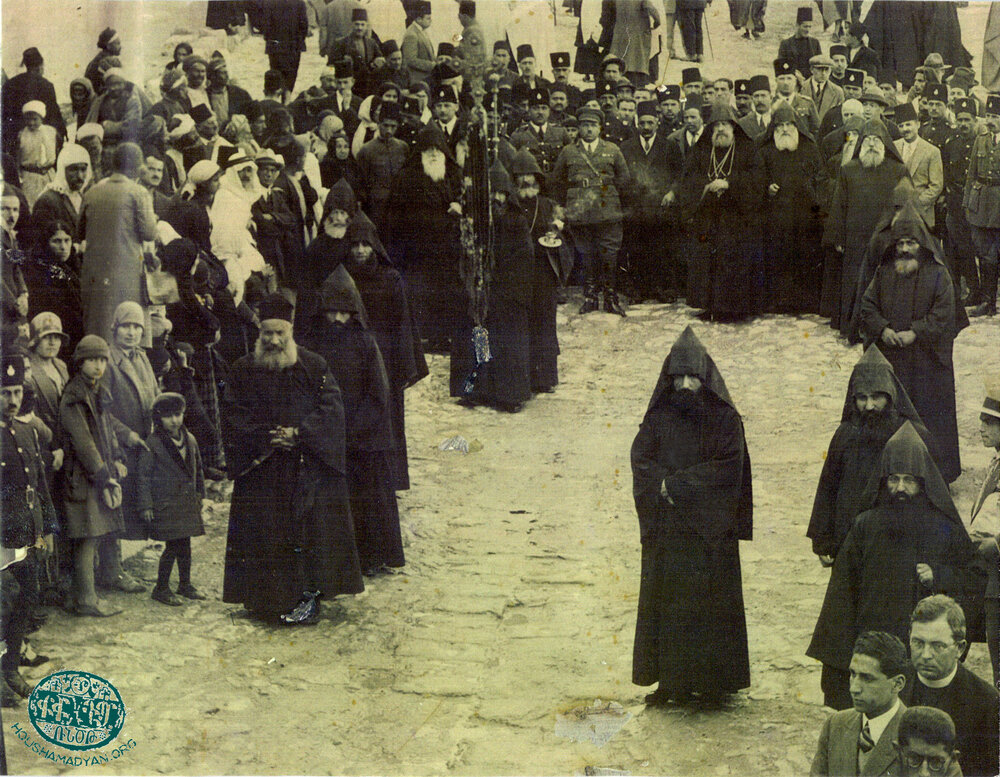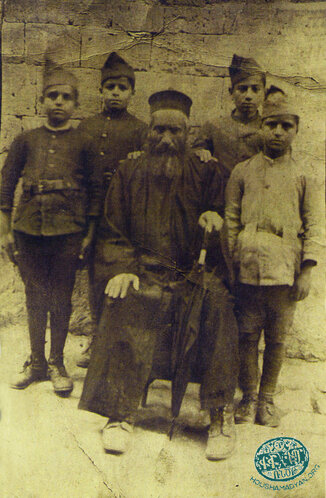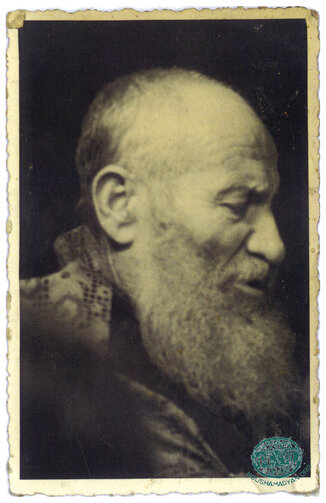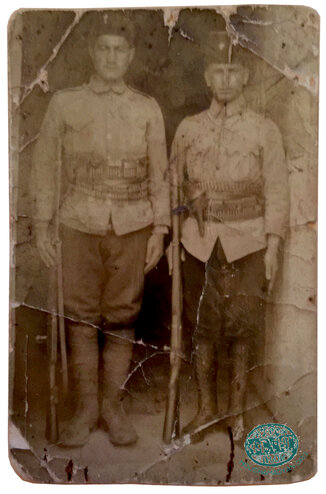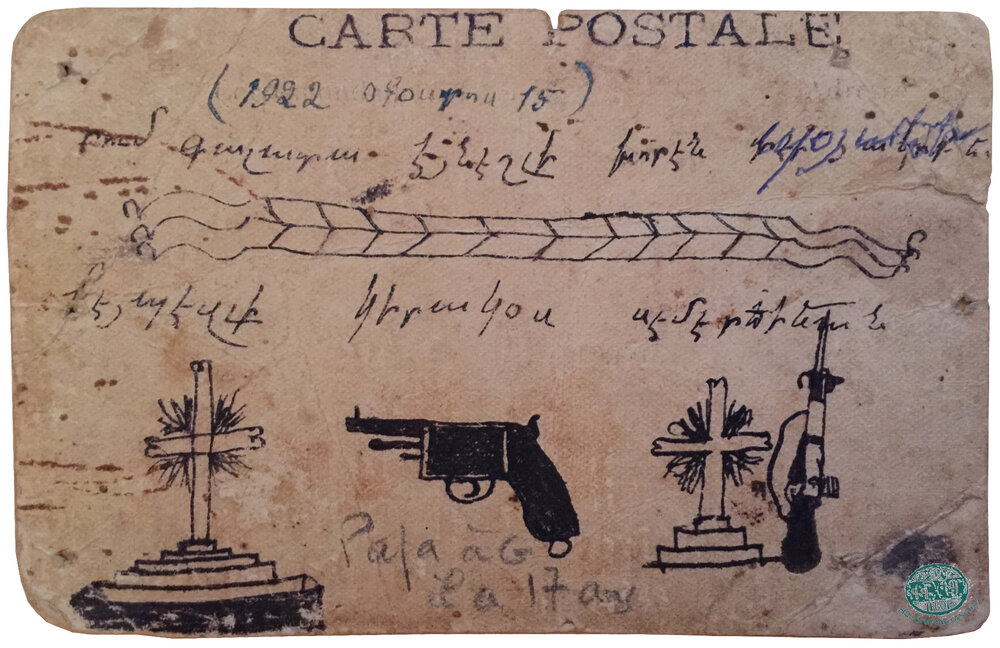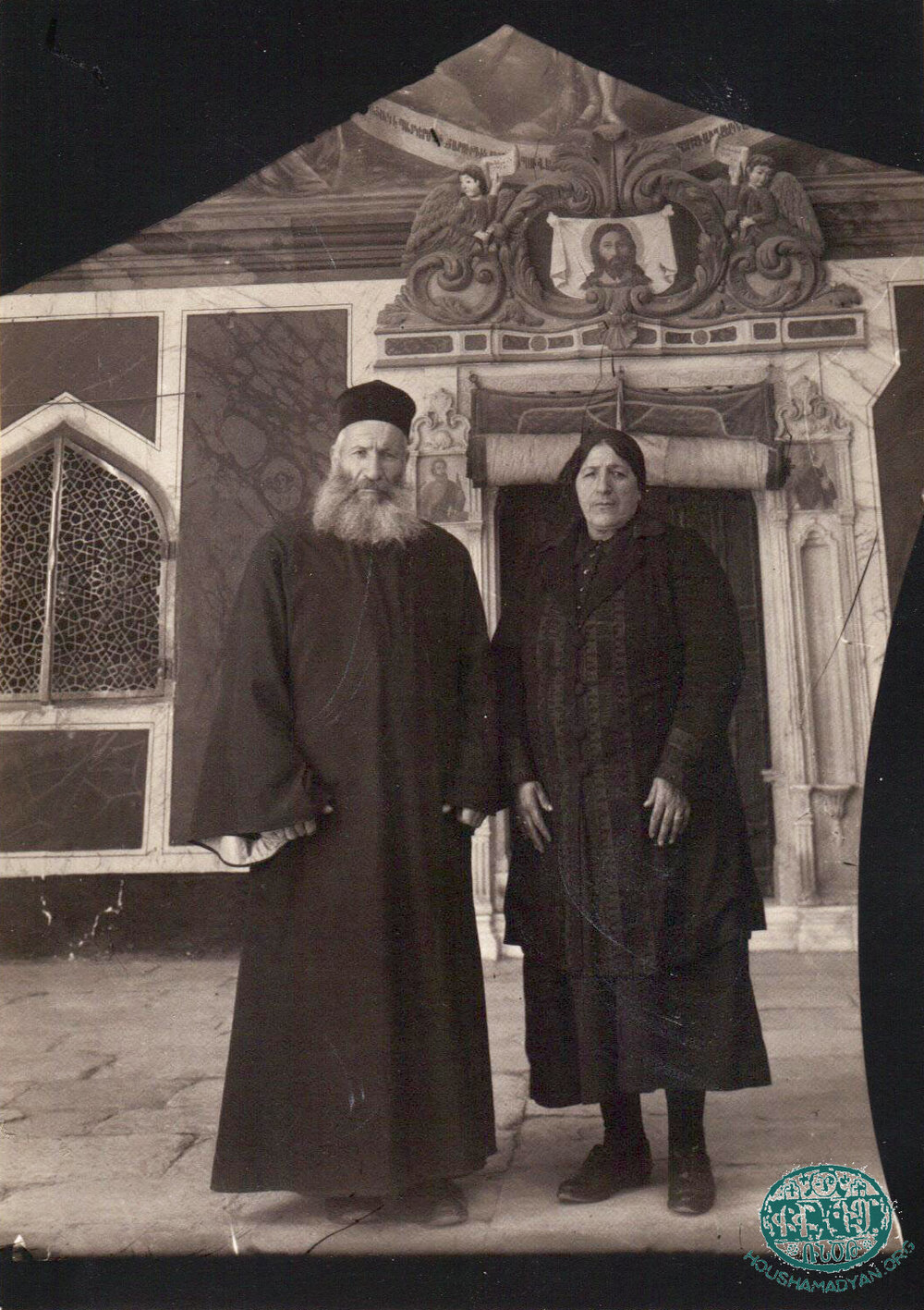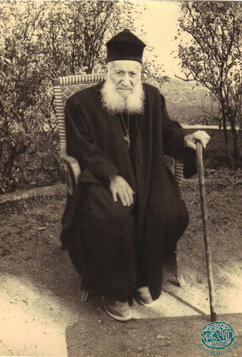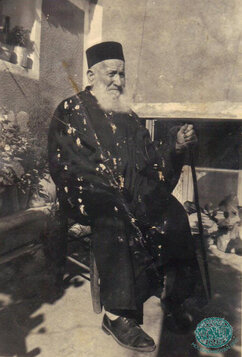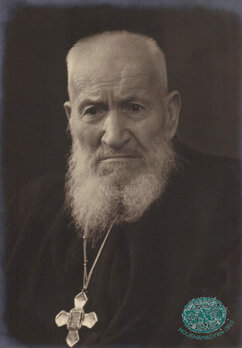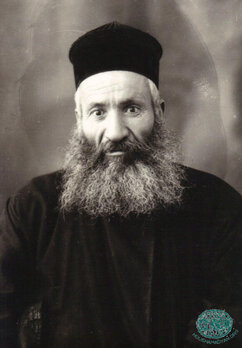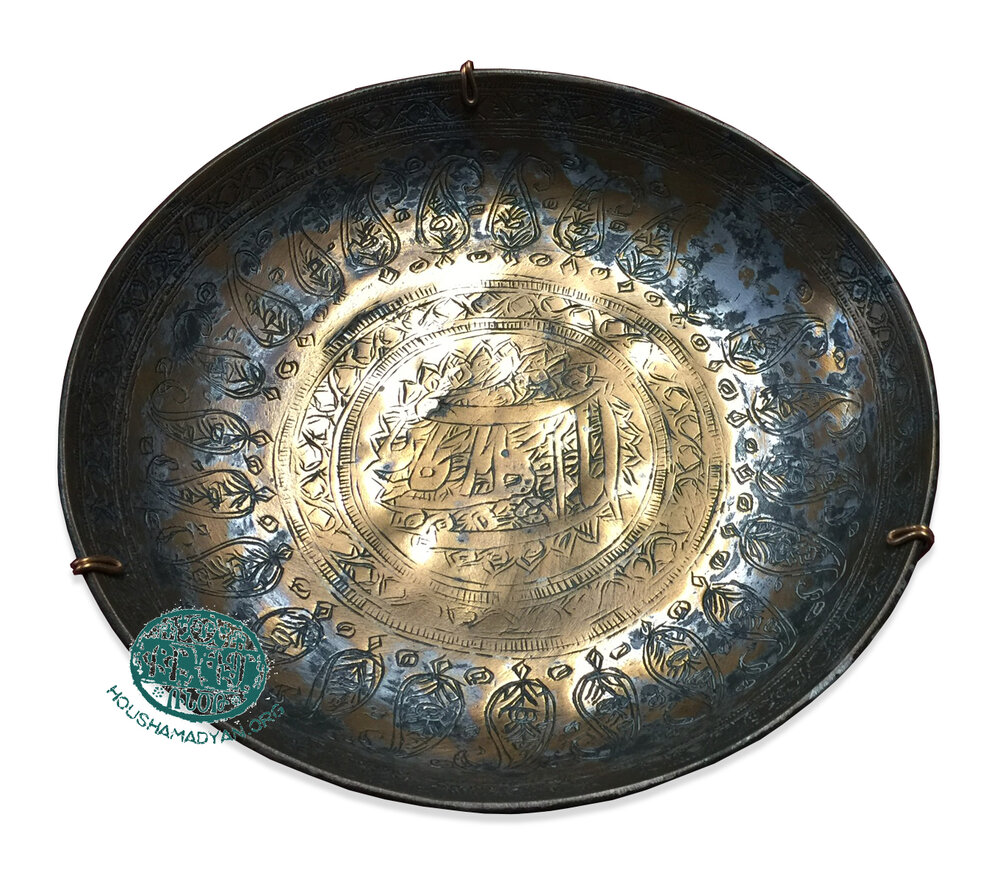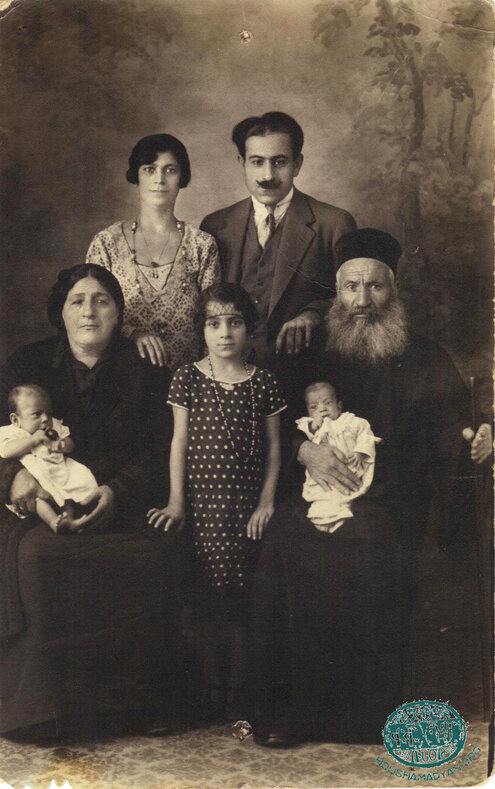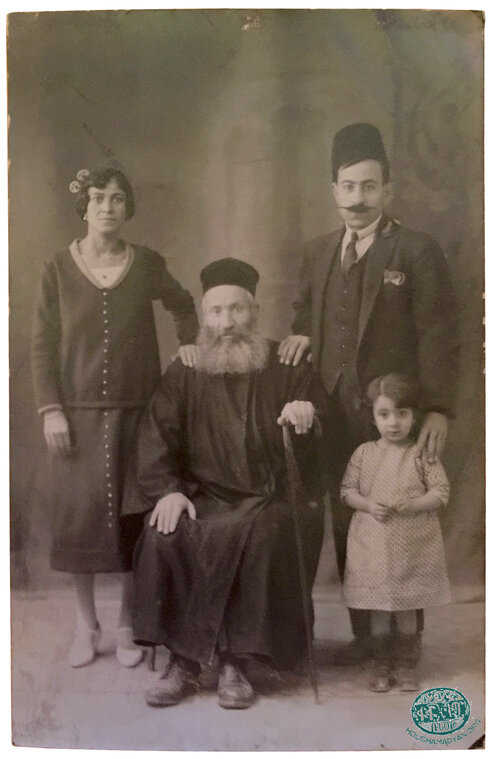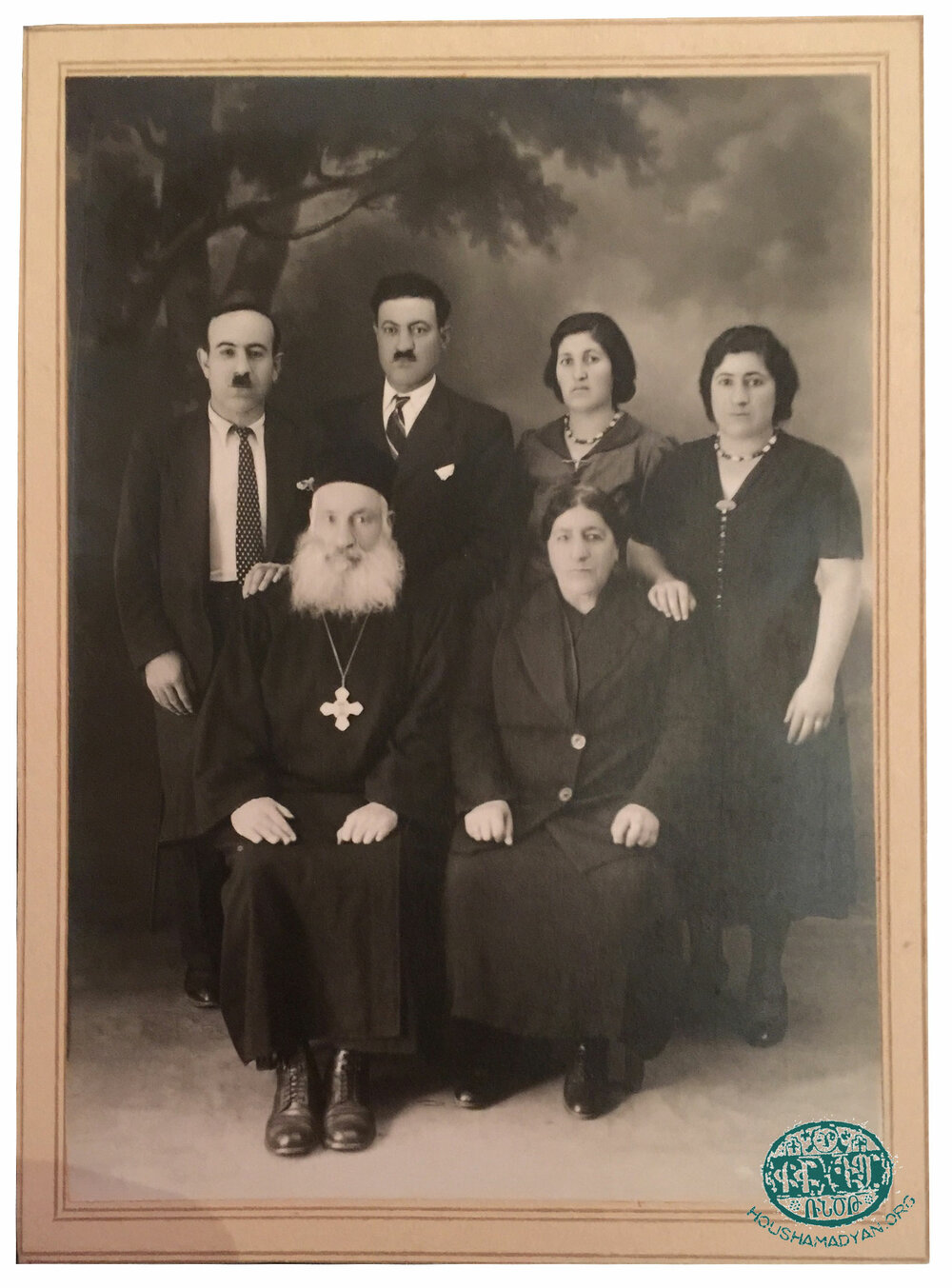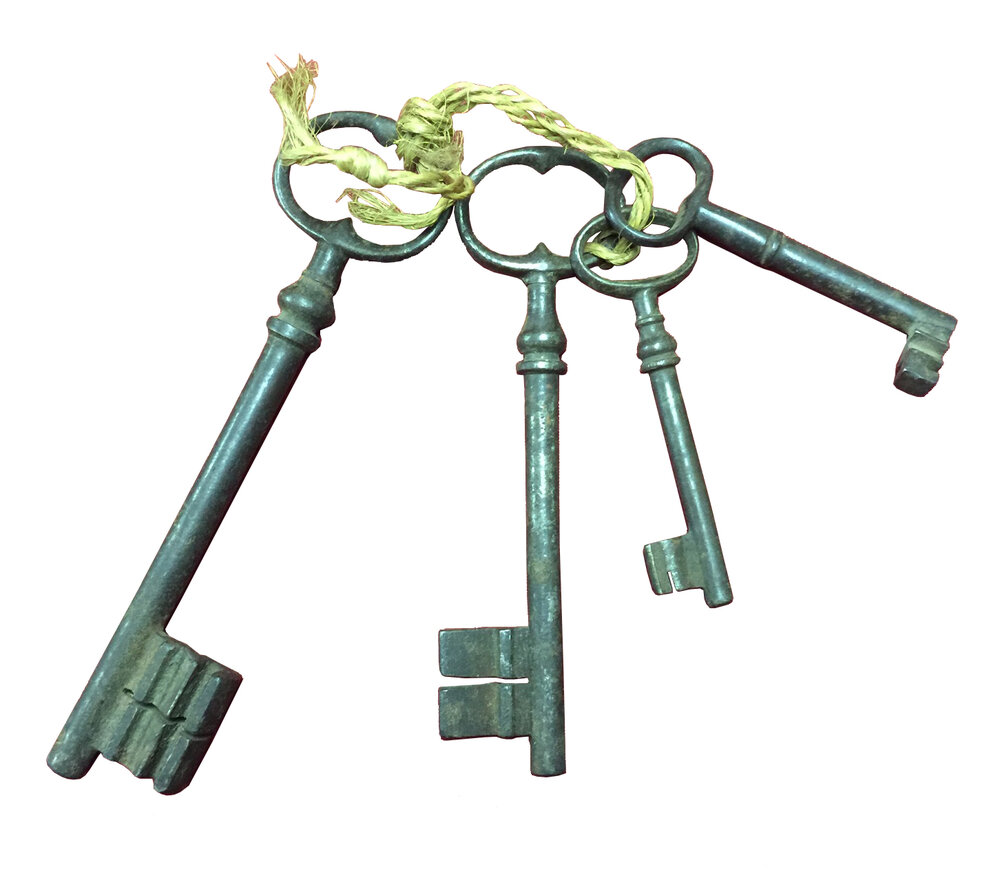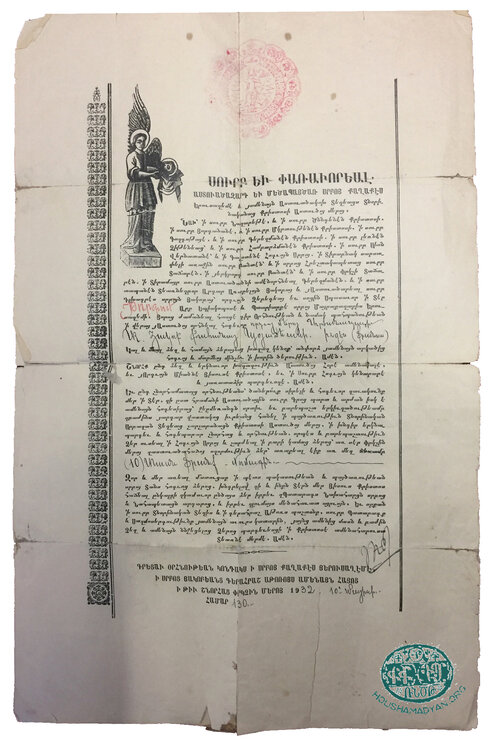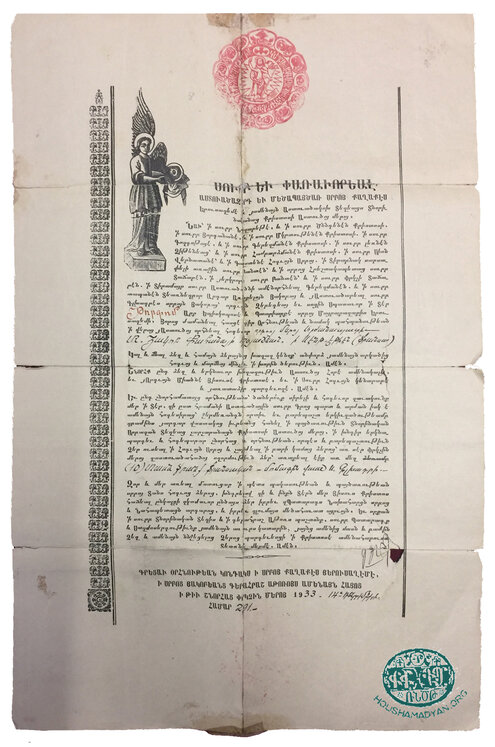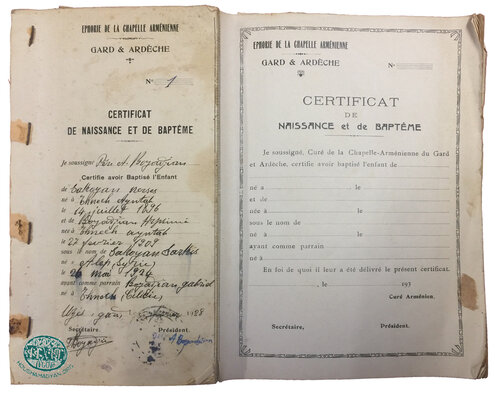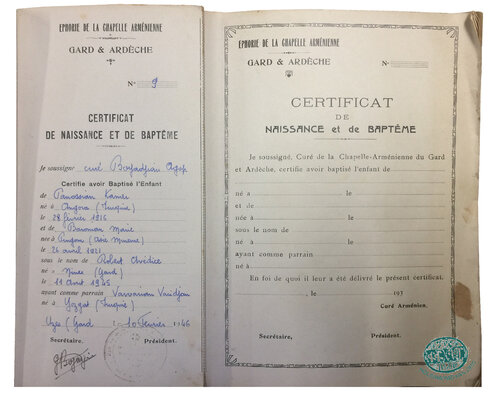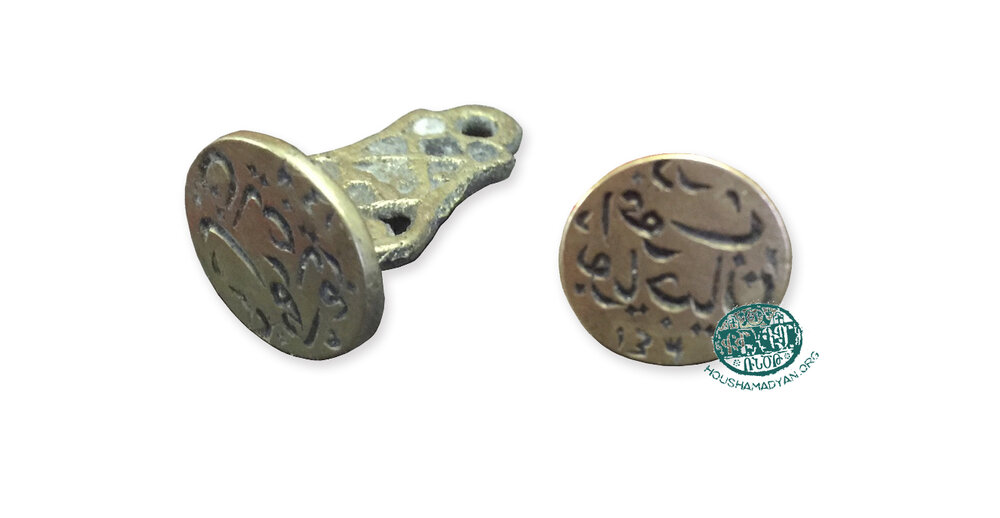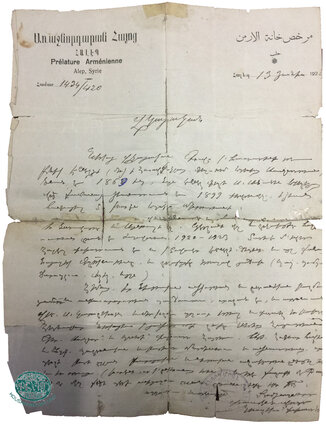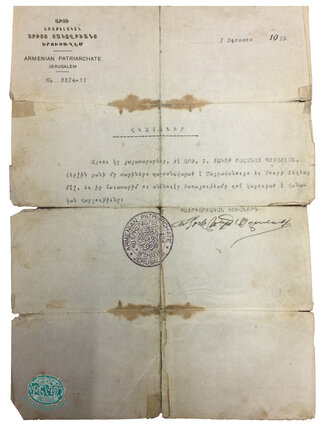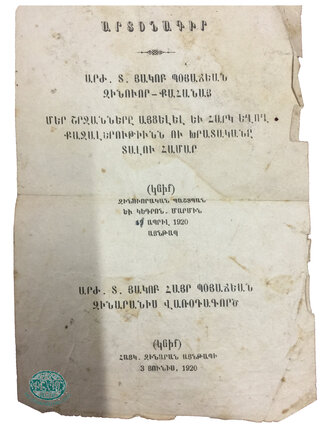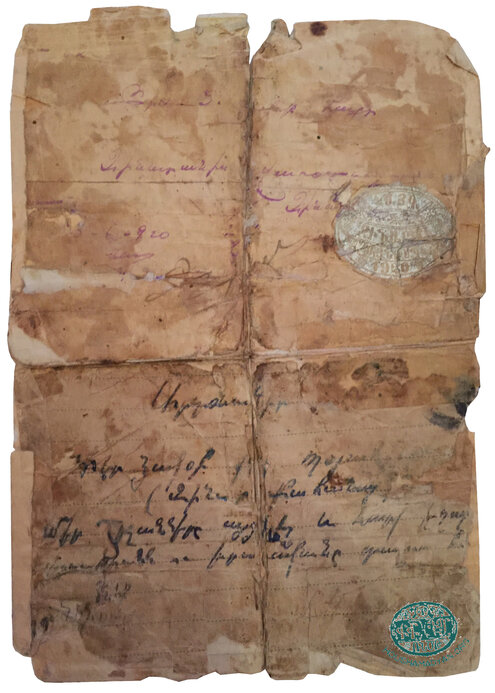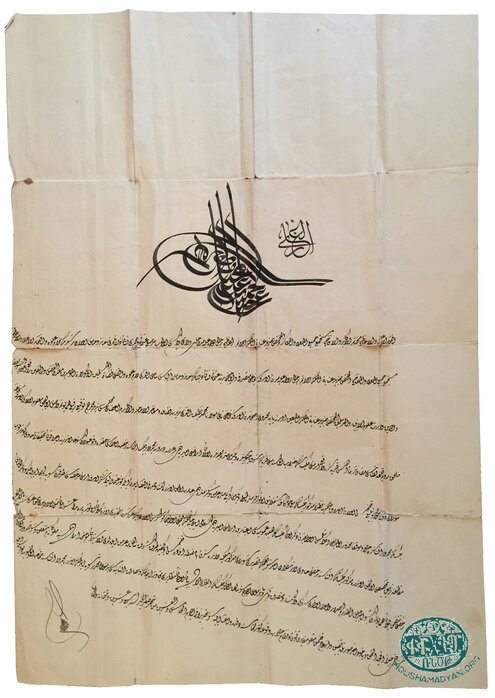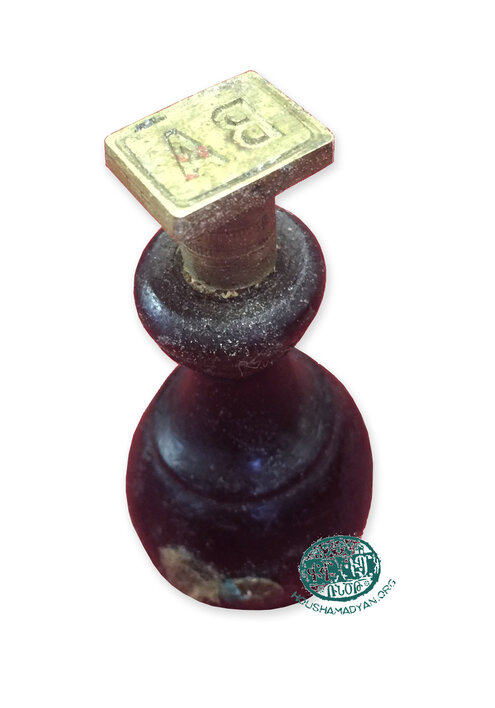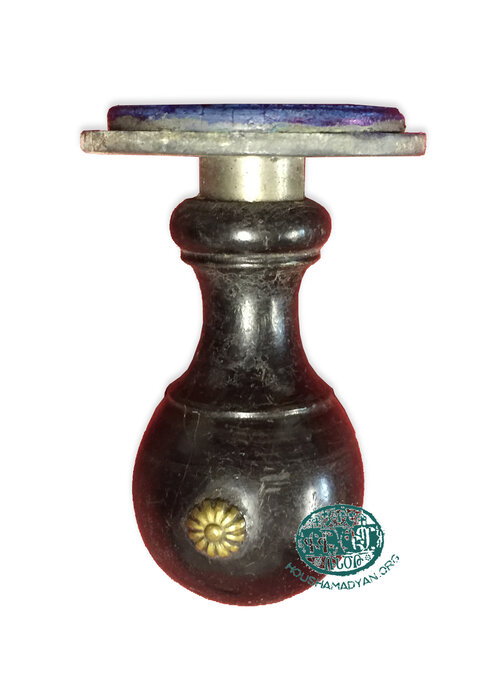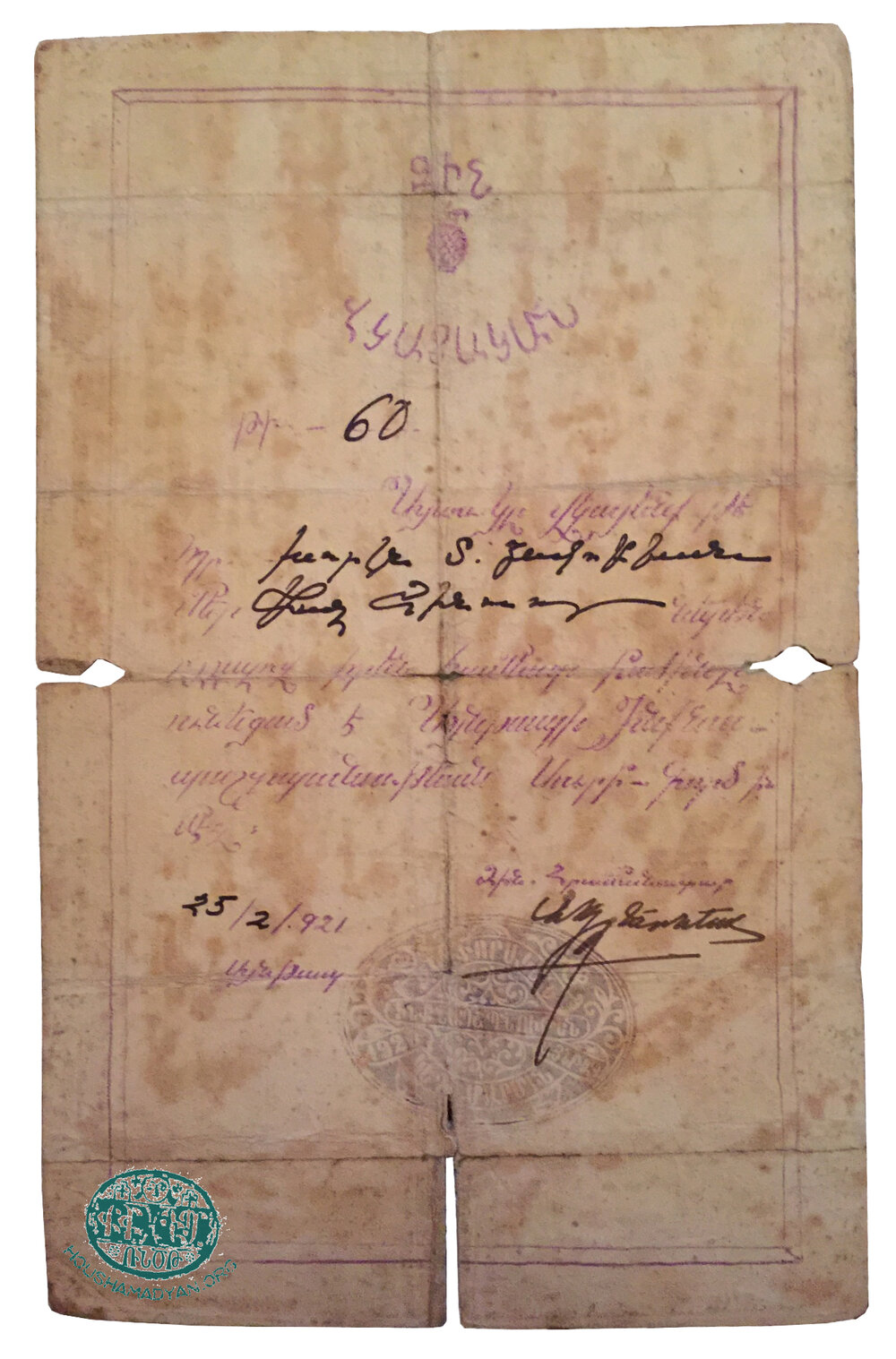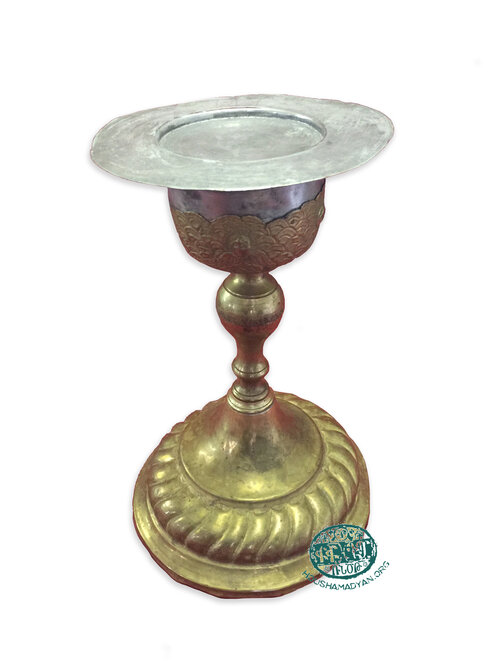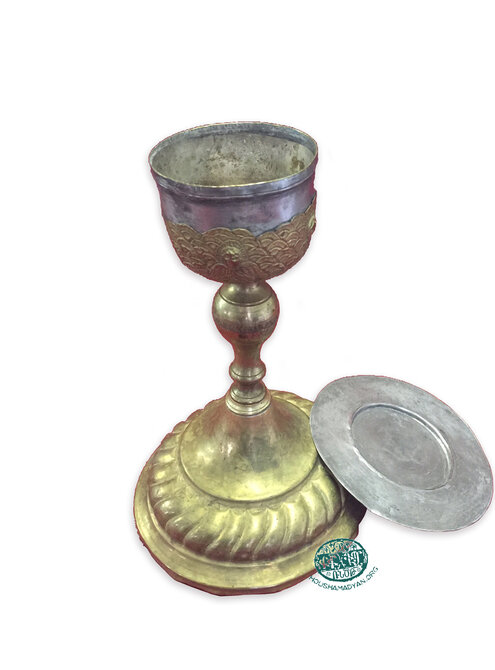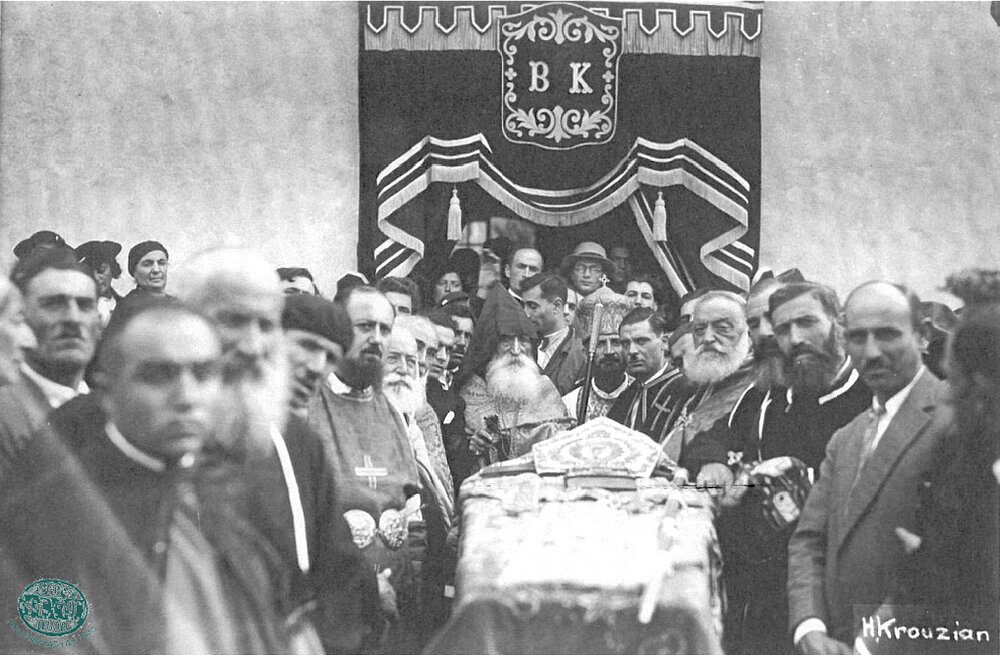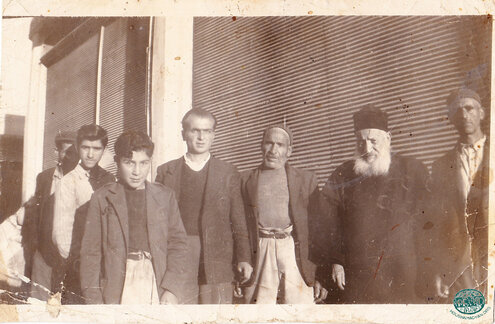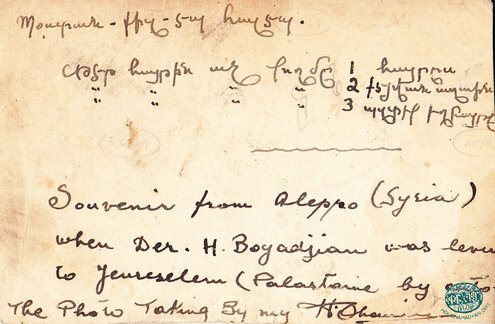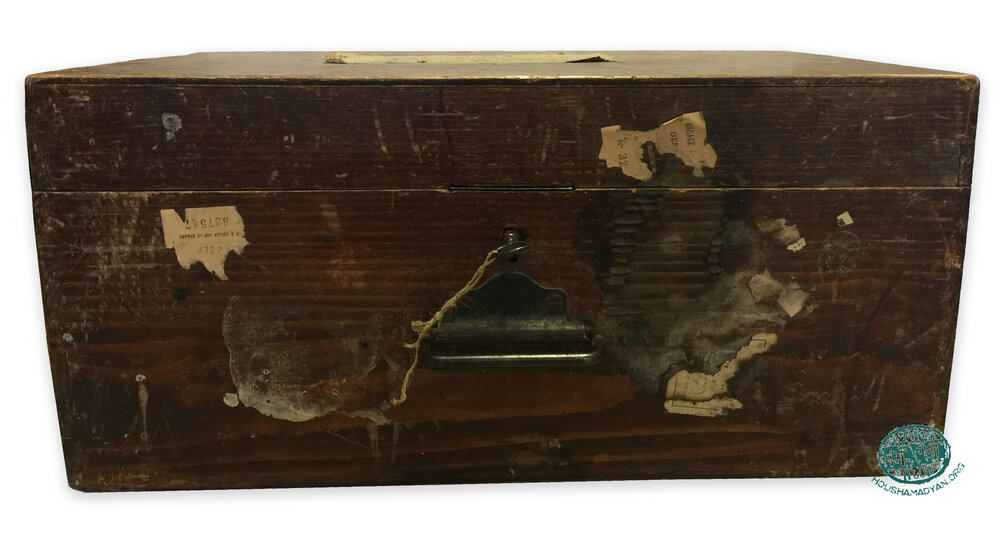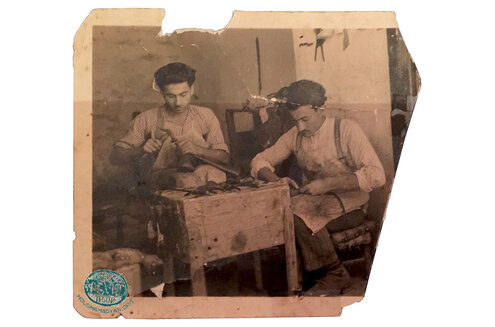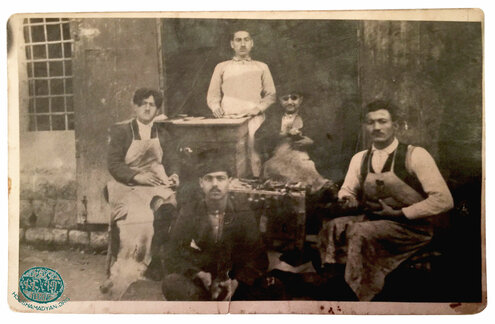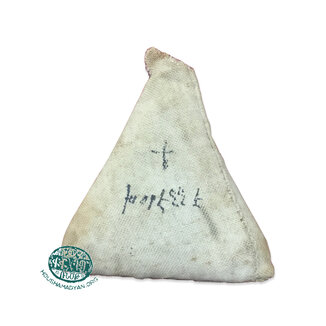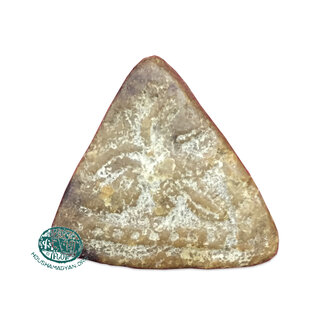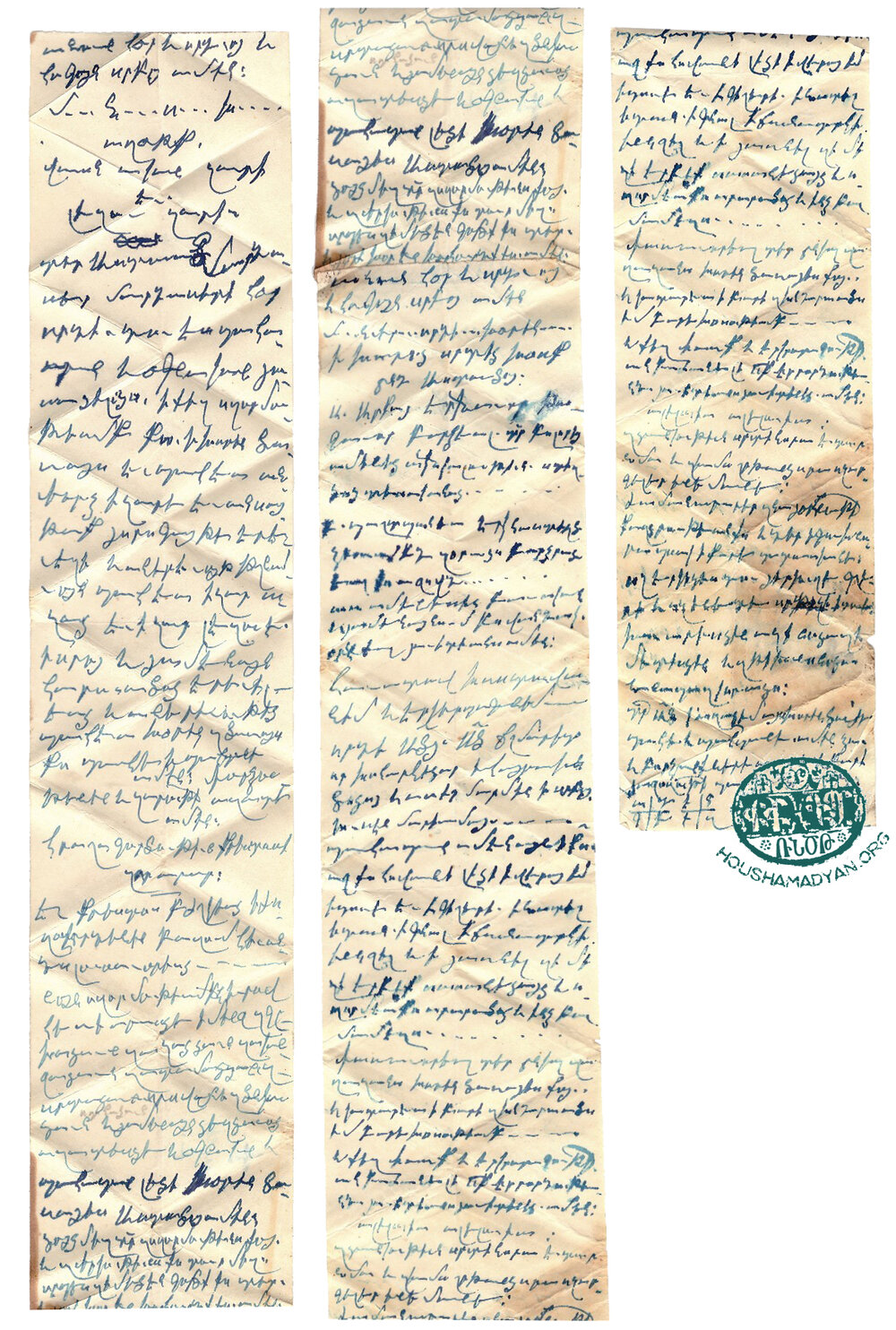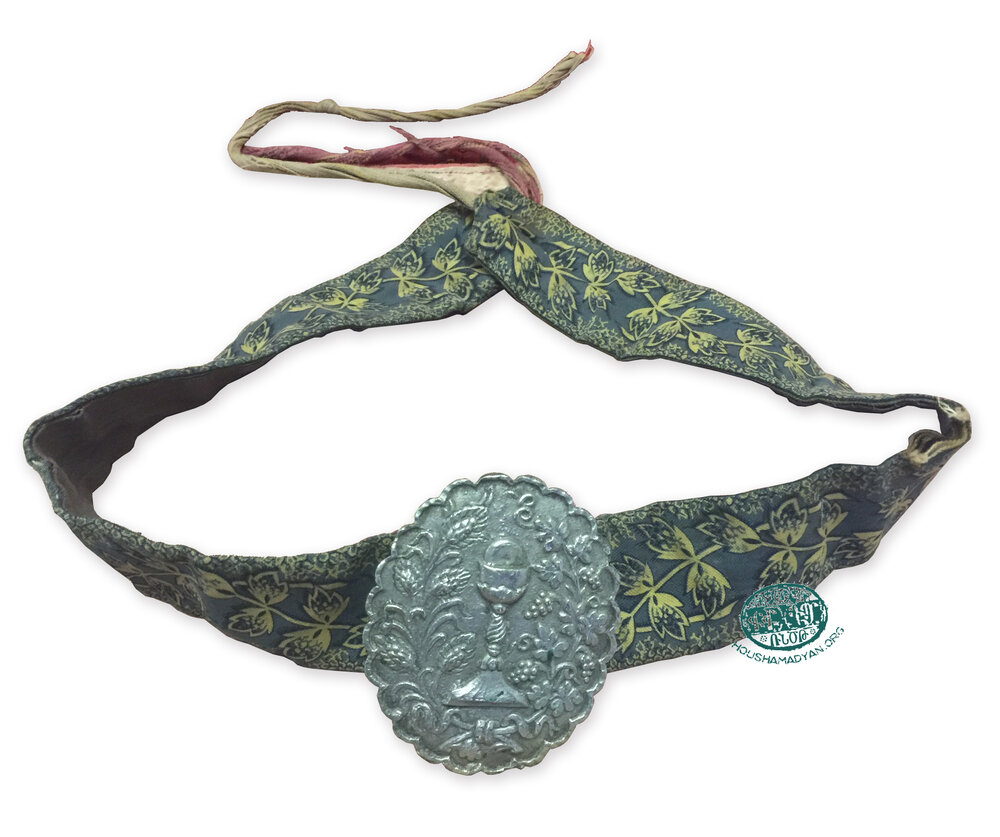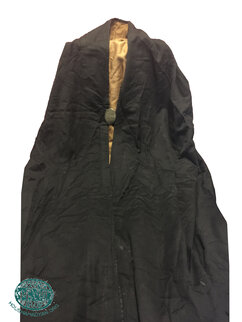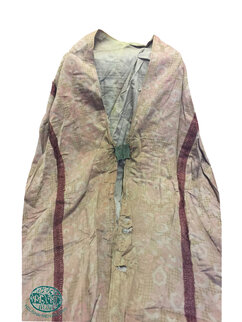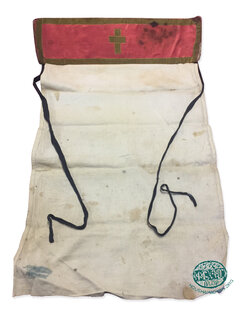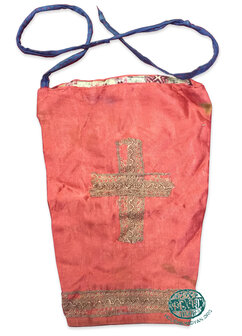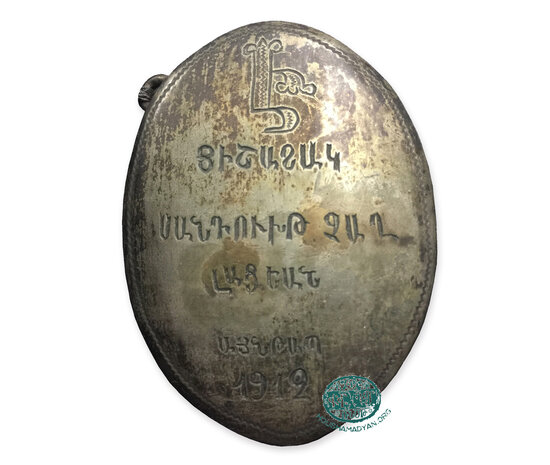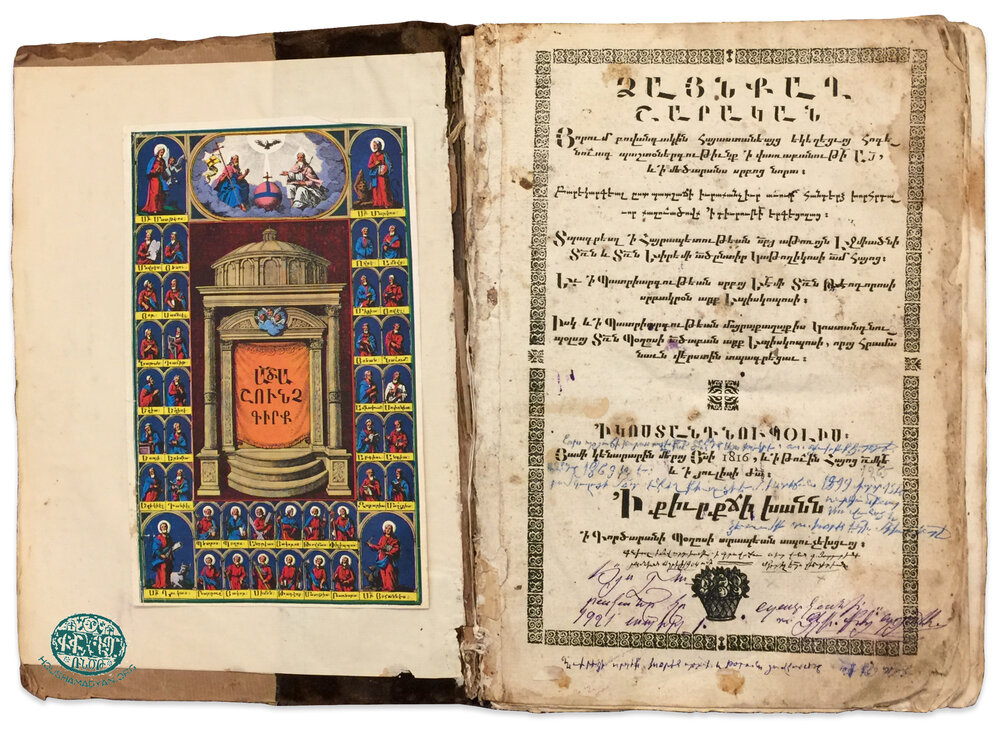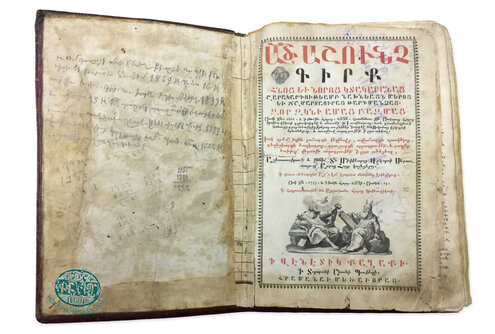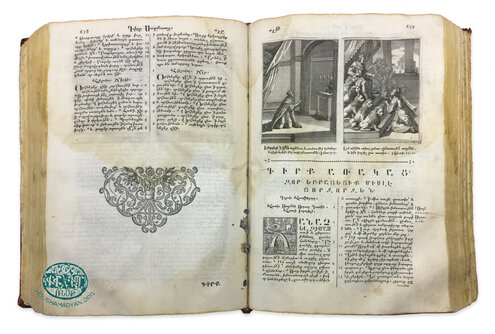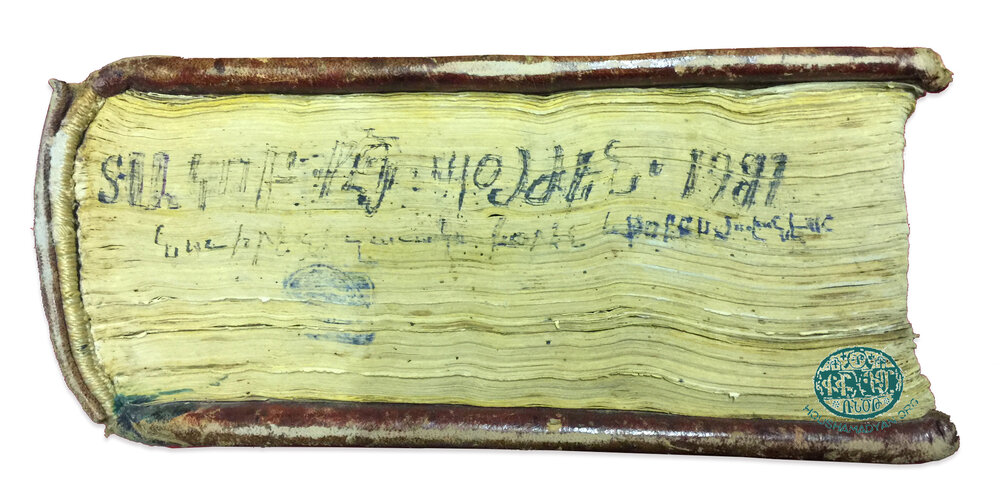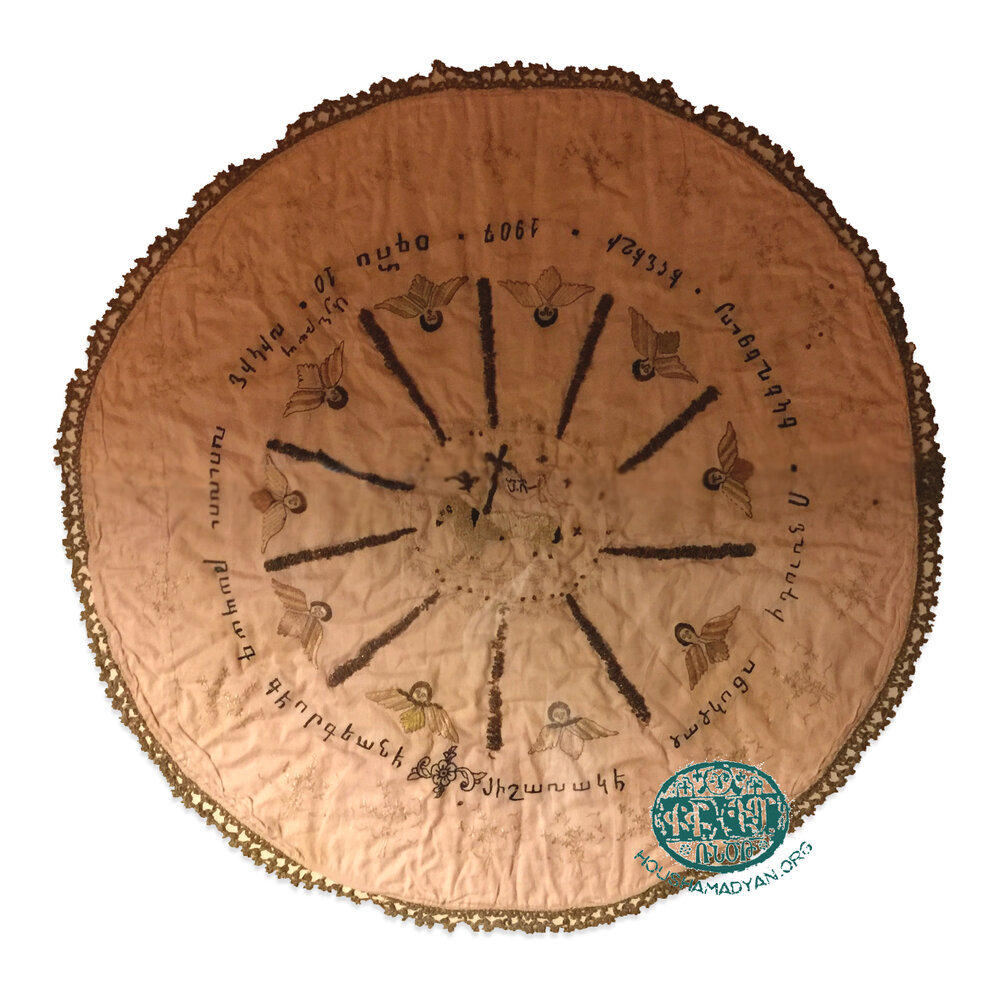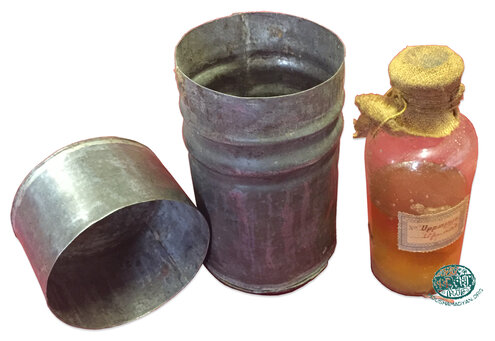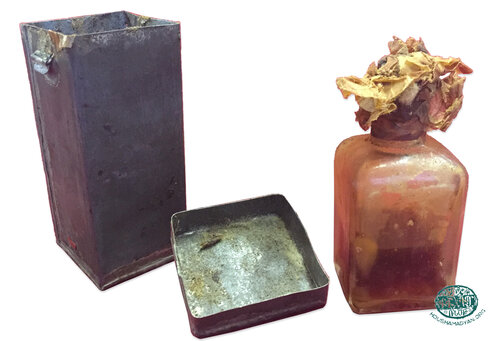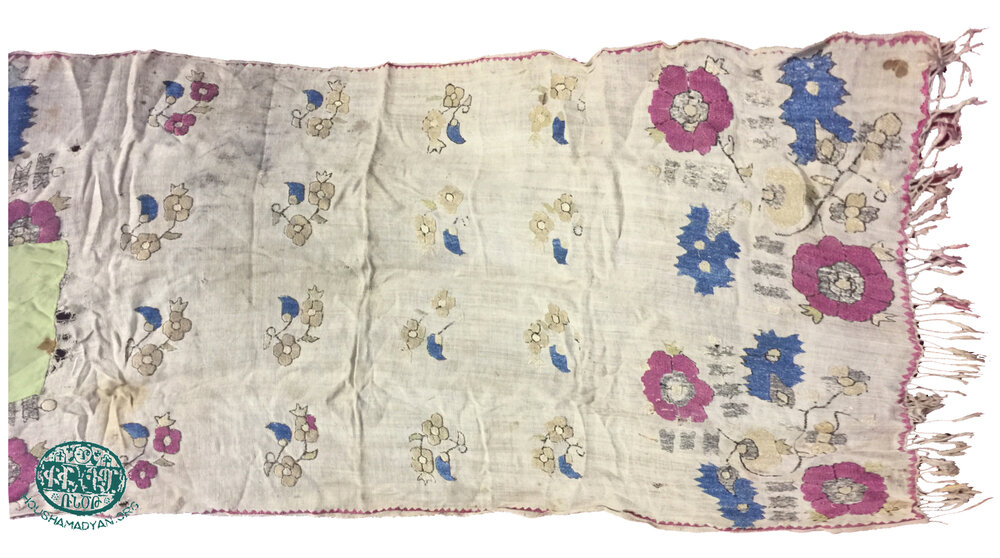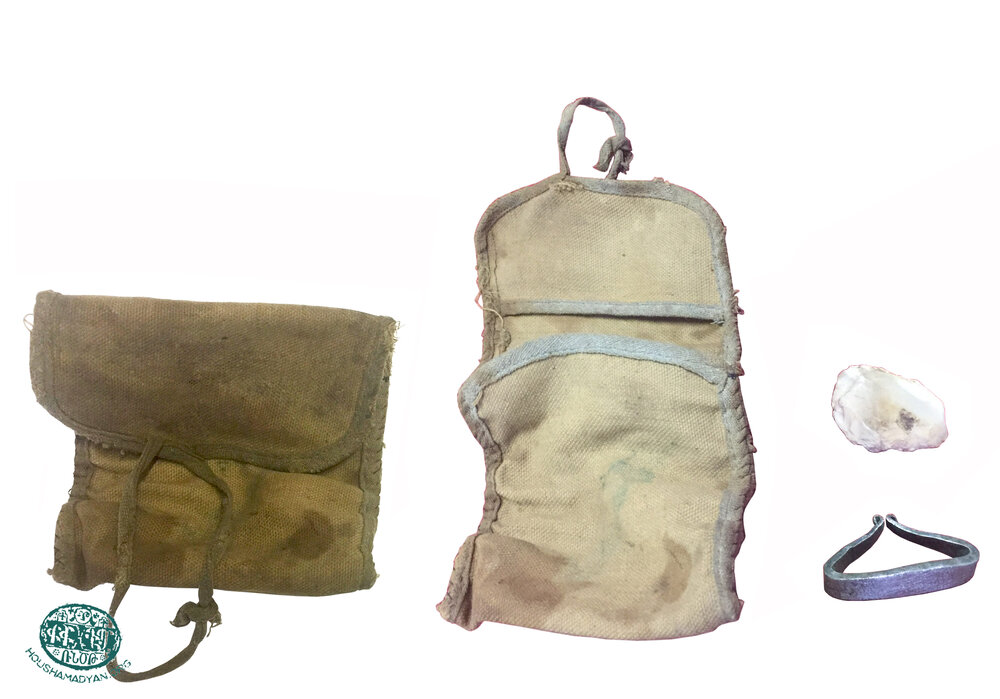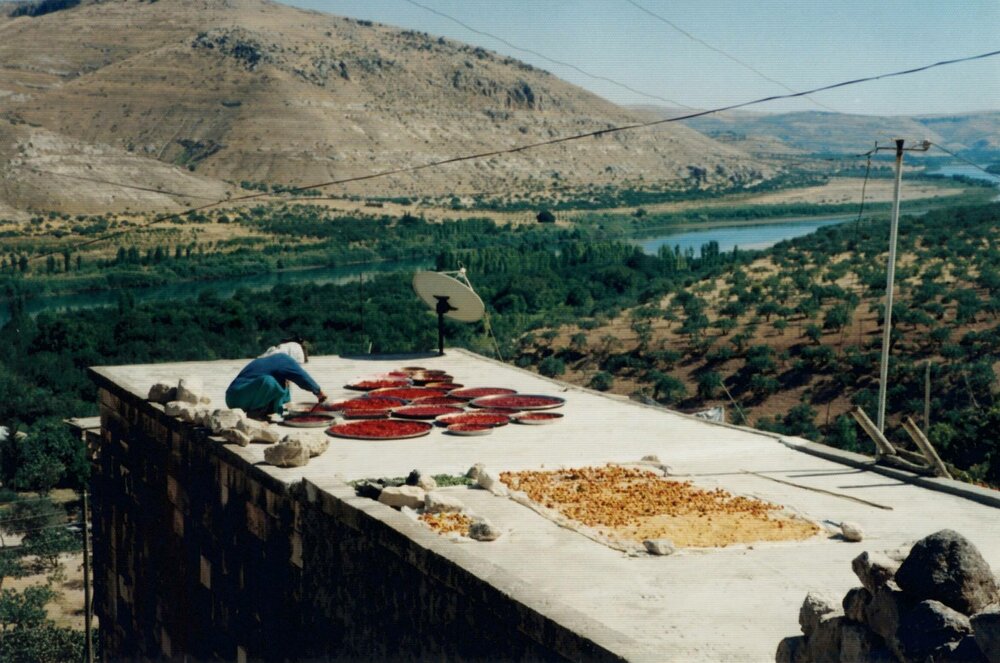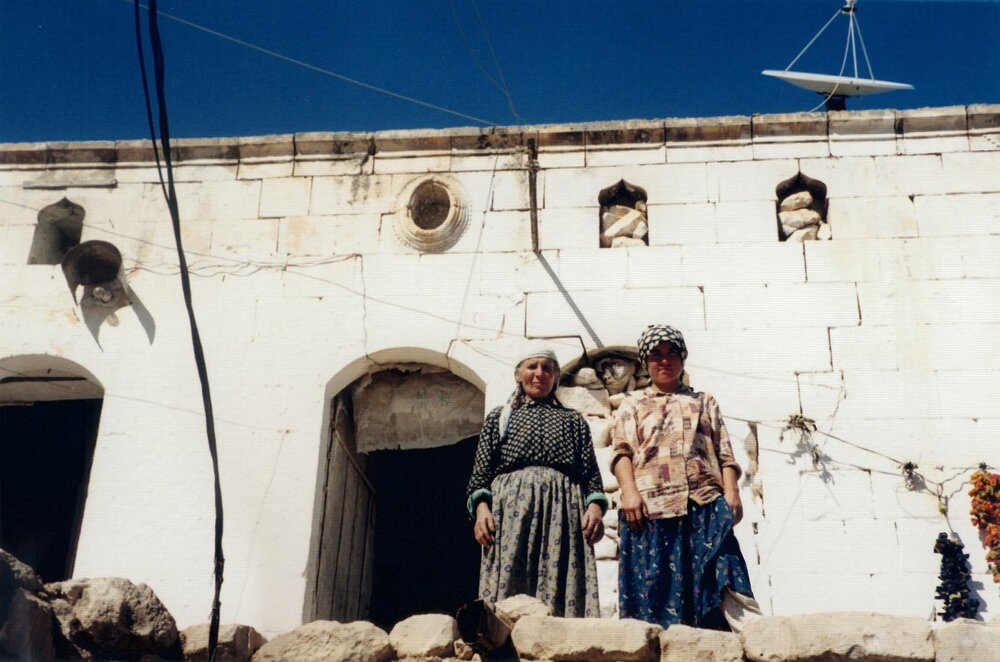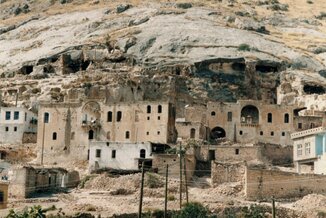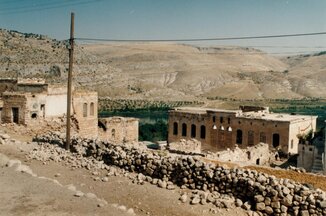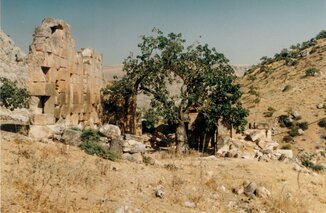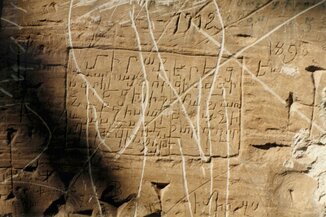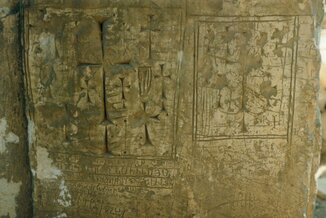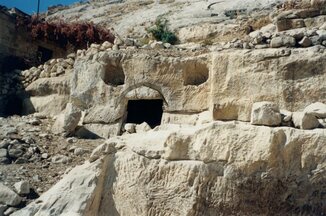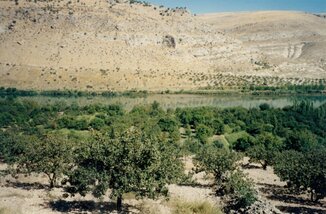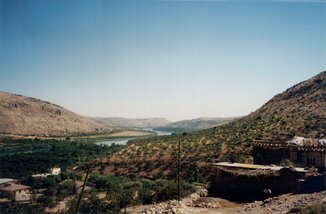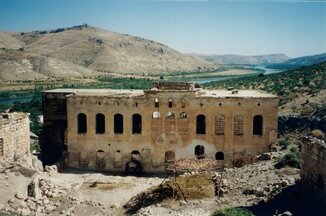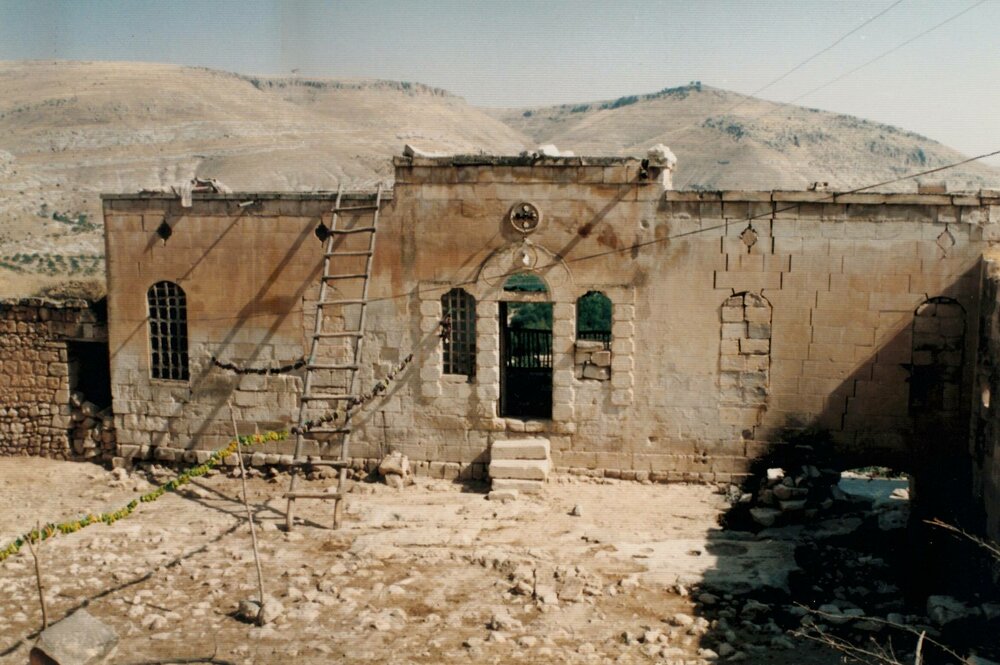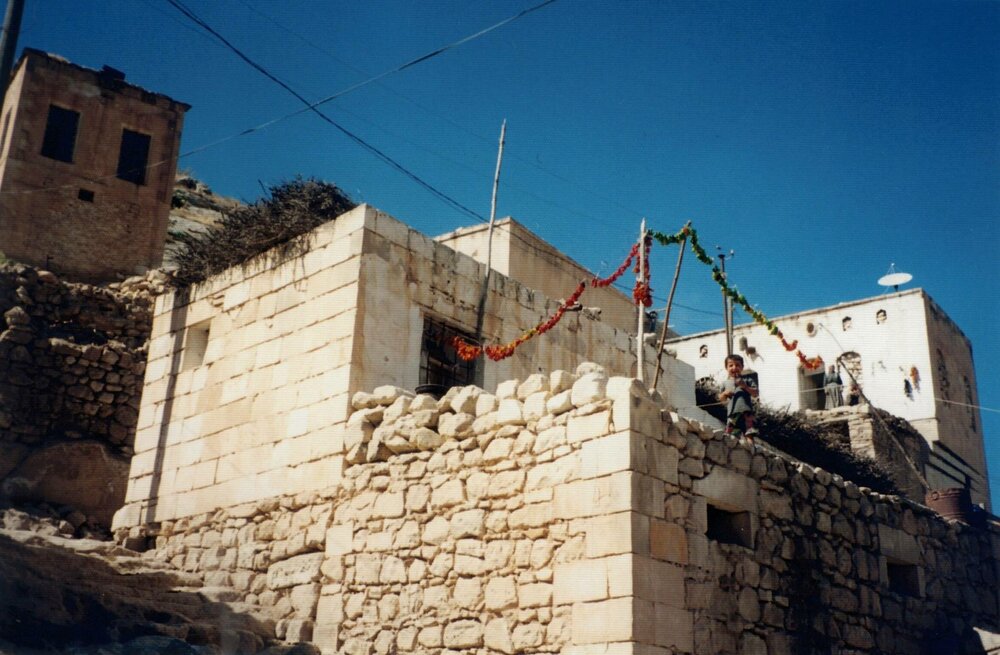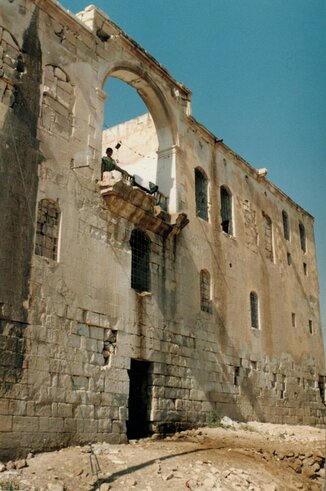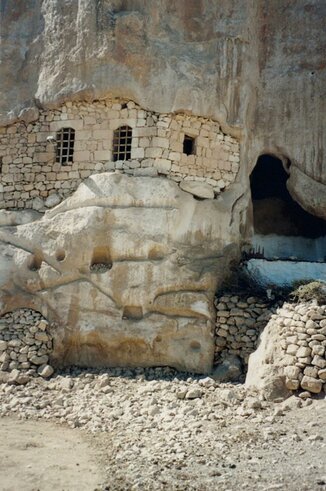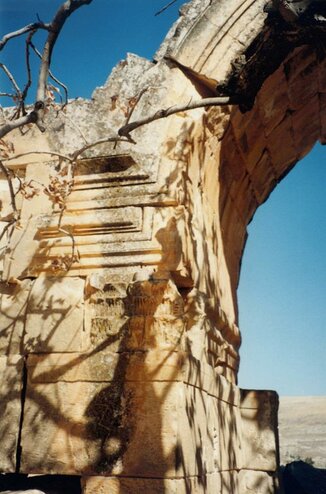Sarafian collection - Paris

The displayed collection was put at Houshamadyan's disposal by Raffi Sarafian and this page is dedicated to his paternal grandmother’s side of the family - the Boyadjian family, which was originally from the village of Eynesh/Ehnesh (present-day Gümüşgün, north-east of the city of Ayntab), situated on the banks of the Euphrates River. The earliest family member that we know of is Toros Boyadjian, who was born in 1850 and was married to Mariam Khanoum Boyadjian, he was Father Hagop Boyadjian’s father, it is the latter's collection of liturgical objects which are displayed on this page. Father Hagop Boyadjian is Raffi Sarafian’s great-great grandfather. Father Hagop was born in 1869 in the village of Ehnesh.
Father Hagop was married to Nver Khatcherian, who was born in 1870 in Ehnesh, and the couple had 8 children, 3 of them perished during the Genocide. The names of their 8 children are: Zakaria, Lousaper, Sarkis, Khoren (Raffi Sarafian’s great grandfather), Gabriel, Hripsime, Mariam and Siranoush. Family history tells us that the Boyadjian family was originally from the region of Van and that they moved to Cilicia during the Arab invasion.
Father Hagop was the priest of the St. Asdvadzadzin church in Ehnesh. He was ordained in Ourfa in 1899 by the bishop of Ourfa, Khoren Mkhitarian. In 1909, during the massacres of Armenians in Adana, Father Hagop played an important role during the Armenians’ self defense in Ehnesh. This could be the reason why he was arrested by the authorities and was imprisoned in Aleppo. He was set free in 1915 and returned to his native village, but was immediately exiled with his family and compatriots. The family was deported to Hama and Homs, many members perished during the deportation and also in the camps because of diseases and starvation.
After the end of WWI, Ayntab and the surrounding area was occupied by the British first, then by the French armies. Father Hagop and the surviving members of his family first returned to Ehnesh, where they would stay for a short while, later, in 1920, they would find themselves in the city of Ayntab. In the same year, the Armenian defense movement against the Turkish nationalist forces started in Ayntab. During these battles, Father Hagop would produce gunpowder, while his three adolescent sons fought in battle. Father Hagop was also sent to different sites to encourage the soldiers and to pray.
After the French evacuation from Cilicia in 1921, the family, like most of the Armenians, left the region and some members, notably his son Khoren and one other brother, moved to Ghazir (a village in north of Beirut, Lebanon). Then they took a boat to Marseille and arrived at the “Quai de la Joliette” like all Armenian immigrants in the 1920’s, they settled in the city of Uzès located in the south of France.
Father Hagop Boyadjian was the priest in Ayntab from 1920 to 1923, then he was the priest in Beylan. Later he settled in Aleppo, where he became the priest of Armenian immigrants from Ehnesh and Jibin. He was also a touring priest for Aleppo's neighboring cities: Al-Bab, Moumbouj, Jarabulus. In 1924, he left Aleppo and served as a priest in Jerusalem for some time.
Sarkis Boyadjian, one of Father Hagop’s sons, settled in Egypt first in the 1920's and then joined his siblings in Uzès, Gard, in Southern France.
Father Hagop joined his children and grandchildren later, after spending some time in Jerusalem with his wife Nver Khatcherian.
This photo was taken in 1926 in Jerusalem close to the Armenian patriarchate of Jerusalem; it is during a procession, in the background we can see the Armenian Patriarch of Jerusalem, Yeghishe Tourian, he is in the crowd, is wearing multiple crosses around his neck and has his hands on top of one another, also in the photo is Archbishop Papken Guleserian (the future Coadjutor of the Catholicosate of Cilicia), he is wearing small glasses, has a white beard and is standing third to the right from Yeghishe Patriarch Tourian. Father Hagop Boyadjian can be seen to the left of the photo, he is the first priest leading the procession.
1. Father Hagop Boyadjian photographed with one of his sons, Gabriel, who is standing behind him on the left, the others are possibly Father Hagop's nephews.
This is the earliest photo of Father Hagop that we know, dated around 1918, because Gabriel Boyadjian would be around 12 years old here.
2. 1940, Father Hagop is photographed during a service; the mass was usually given in Turkish, which was a common practice, in order to also reach the Turkish-speaking Armenian believers.
3. Father Hagop Boyadjian’s son Khoren Boyadjian is the one on the left wearing army uniform. He is photographed with a comrade in Ayntab in 1920.
The backside of the photo above of Khoren Boyadjian and a comrade in Ayntab. From what is written on the back of the photo we can assume that the name of the comrade on the right is Giragos Semerdjian. The date "August 15, 1922" noted at the top, does not correspond to the date of the events during the Armenian resistance in Ayntab, but could possibly correspond to the date when the note was taken by a family member. It is also noted that Khoren, standing on the left, is about 17 years old.

Four different photographs from Father Hagop.
In the first photo, Father Hagop Boyadjian is photographed in the Armenian old age house in St. Raphael, France (“Ephad Home Arménien”) in 1955.
The second photo was taken in the garden of his son Khoren in Uzès, Gard, France, in 1954.
There are no dates for third and fourth photographs.

1. Father Hagop and his wife Nver, standing behind him is his son Sarkis and his daughter-in-law Azniv standing next to him; Hagop and Never are holding their grandchildren, the twin brothers who died shortly after this photo, the little girl standing between them is Marie, their granddaughter. Cairo, 1927.
2. Father Hagop photographed with his son’s family in Cairo in 1925. Standing from left to right are: Azniv, Hagop’s daughter-in-law, Sarkis, his son, and Marie, their daughter.

Father Hagop Boyadjian and his wife Nver photographed with their 2 sons, their daughter-in-law and their daughter in France, in the 1930’s.
Standing from left to right are: Sarkis and Khoren (Father Hagop's sons, Khoren is Raffi Sarafian’s great-grandfather), Hayganoush (Khoren’s wife), and Hripsime (Hagop and Nver’s daughter).
Birth and baptism certificates issued by the Armenian church in Uzès, Gard, France. Father Hagop Boyadjian is the priest who has baptized these children.
1. This document, dated: 1938, certifies that Sakoyan Sarkis (born in Aleppo, 26 May, 1924), the son of Sakoyan Nerses (born in Ehnesh, Ayntab, 14 July, 1896) and Boyadjian Hripsime (born in Ehnesh, Ayntab, 27 February, 1909) has been baptized. The godfather is: Boyadjian Gabriel (born in Ehnesh).
2. This document, dated: 10 February, 1946, certifies that Robert Avedis (born in Nimes [Gard] 11 August, 1945), the son of Panossian Kamer (born in Angora, Turkey, 28 February 1916) and Baronian Marie (born in Pingan, [present-day Adatepe], Asia Minor [vilayet of Sivas], 26 April, 1921, has been baptized. The godfather is: Varvarian Varoujan (born in Yozgat).
1. Certificate (from June 13, 1924) given to Father Hagop Boyadjian from the Armenian Prelacy of Aleppo. It is mentioned in the certificate that Father Hagop has served in Aleppo and has currently decided to serve elsewhere. Suitable bodies are encouraged to help Father Hagop in his efforts in finding work and settling in a new place.
2. Certificate (from August 7, 1929) issued by the Armenian Patriarchate of Jerusalem, where it is mentioned that during the last years, Father Hagop had served in the monastery of Jerusalem and its surrounding regions. The certificate is signed by Archbishop Mgrditch Aghavnouni, locum tenens for the Patriarchate.
3. This document dated 3 June 1920 is from the time period of the Armenian resistance of Ayntab. It reads: "Permission to leave for Father Hagop Boyadjian (soldier-priest) to visit the regions in order to give the necessary encouragement and advice". We also learn from this document that Father Hagop was also the gunpowder maker of the Armenian arsenal in Ayntab.
1. This document from 3 June 1920 is from the period of the Armenian resistance in Ayntab. It is written: "Permission for Father Hagop Boyadjian (soldier priest) to visit surrounding areas and give the necessary encouragement and advice."
2. Ottoman firman in divanli authorising the construction of a new church in Ehnesh.
Military certificate given to Khoren Boyadjian from Adour Levonian, the military commander (1 April 1920 - 8 February 1921) during the Armenian resistance in Ayntab.
It says: "Military certificate no 60. We certify that Mr Khoren D. Hagopian, being one of our brave soldiers, has had his (?) part in the sacred work of the Ayntab self defence. 25/02/1921, Ayntab, commander: A. [Adour] Levonian".
This is a historical photo; it depicts the funeral of Archbishop Grigoris Balakian in 1934 in Marseille.
The priest in the background is Vramshabouh Kibarian (to see more on the latter please see our ODA page dedicated to the Kibarian family HERE).
Father Hagop Boyadjian used to travel all over the Middle East even when he was very old, here he is in the Bostan Pasha district in Aleppo meeting with Ehnesh compatriots; Hagop Keywanian and Ohanian family members in 1944. On the right is displayed the backside of the photograph where information is given on the place, date and identity of the people in the photo.
Father Hagop Boyadjian’s sons, including Khoren, learning shoe making in Ghazir, north of Beirut, the 1920s; in one of the Armenian orphanages of the Near East Relief which was established in this Lebanese village with the leadership of the Swiss Jakob Künzler. A small Armenian community had also settled in Ghazir, the Boyadjian family was part of them.

These are amulets, which hold folded prayer scrolls. The first one has the name: Khoren on it and was meant for the son of the priest who wrote it. The last one is the one which was opened by mistake.
Raffi Sarafian's great-great-grandfather Father Hagop Boyadjian used to write prayers on scrolls (Հմայիլ [hmayil] in Armenian) and give them to members of his family to protect them. These scrolls were folded using a triangle pattern and were inserted in a triangle folded fabric. These amulets were not meant to be opened. One of these amulets was passed on to Raffi Sarafian, and his young son opened it my mistake, you can see the scanned version of the prayers below. This scroll was written nearly a hundred years ago by father Hagop, who passed it on to his son Khoren Boyadjian, who kept it close to his heart when fighting during the battle of Ayntab; Khoren survived. The amulet has been passed down from generation to generation and is currently kept in Paris as part of the Sarafian family collection.
A book of hymns, published in Istanbul in 1816. There are inscriptions on the first page from different time periods. Some of these inscriptions are illegible. We learn from these writings that the book was purchased in 1904. In 1921, the following is written: "this Hymn book belongs to Father Hagop Boyadjian, April 1921". The writing at the bottom is Father Hagop's note, he says that he gifts the book to his son Toros and grandson Hovhanness.
A round embroidered cover from the Ehnesh church from August 1907. The embroidered Armenian text reads: «Ծածկոց ի դուռն Ս. եկեղեցւոյ Էհնէշի 1907 Օգոստոս 10 Այնթապ, տիկին Տուտու Թապագ Գէորգեանէ», a cover as a souvenir from Mrs Doudou Tabak Kevorkian to the holy church of Ehnesh, Ayntab, 10 August, 1907.


Recent photos from the village of Ehnesh


